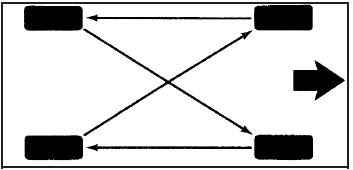Tire Inspection and Rotation
We recommend that you regularly inspect your vehicle’s tires, including the spare tire, for signs of wear or damage. See When It Is Time for New Tires for more information.
Tires should be rotated every 5,000 to 8,000 miles (8 000 to 13 000 km). See Scheduled Maintenance .
The purpose of a regular tire rotation is to achieve a uniform wear for all tires on the vehicle. This will ensure that your vehicle continues to perform most like it did when the tires were new.
Any time you notice unusual wear, rotate the tires as soon as possible and check wheel alignment.
Also check for damaged tires or wheels. See When It Is Time for New Tires and Wheel Replacement.

When rotating the vehicle’s tires, always use the correct rotation pattern shown here.
Do not include the compact spare tire in the tire rotation.
After the tires have been rotated, adjust the front and rear inflation pressures as shown on the Tire and Loading Information label. See Inflation - Tire Pressure and Loading the Vehicle.
Reset the Tire Pressure Monitor System. See Tire Pressure Monitor Operation.
Make certain that all wheel nuts are properly tightened. See “Wheel Nut Torque” under Capacities and Specifications.
WARNING:
Rust or dirt on a wheel, or on the parts to
which it is fastened, can make wheel nuts
become loose after time. The wheel could
come off and cause an accident. When you
change a wheel, remove any rust or dirt from
places where the wheel attaches to the
vehicle. In an emergency, you can use a
cloth or a paper towel to do this; but be sure
to use a scraper or wire brush later, if
needed, to get all the rust or dirt off. See
Changing a Flat Tire.
See also:
Starter Switch Check
WARNING
When you are doing this inspection, the vehicle could move suddenly. If the vehicle
moves, you or others could be injured.
1. Before starting this check, be sure there is enough room aro ...
How the System Works
When the vehicle is started, both outside mirror displays
will briefly come on to indicate that the system is
operating. While driving forward, the left or right side
mirror SBZA display will ...
Engine Compartment Overview
A. Engine Air Cleaner/Filter .
B. Electric Engine Cooling Fan (Out of View). See Cooling System .
C. Engine Oil Dipstick. See “Checking Engine Oil” under Engine Oil .
D. Engine Oil Fill Cap. ...


